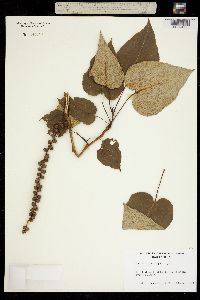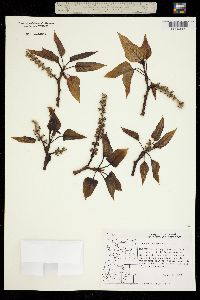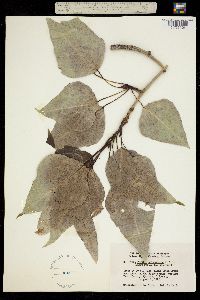Populus trichocarpa
|
|
|
|
Family: Salicaceae
Black Cottonwood
[Populus balsamifera subsp. trichocarpa (Torr. & A.Gray) Hultén, morePopulus trichocarpa var. trichocarpa] |
Plants to 75 m, 26 dm diam.; moderately heterophyllous. Bark grayish brown, deeply furrowed. Branchlets reddish brown, becoming gray by third year, round, 1.5-3(-7) mm diam., coarse, usually densely hairy. Winter buds red, sparsely hairy or glabrous, resinous (resin red, abundant, very fragrant); terminal buds 8-15(-20) mm; flowering buds clustered distally on branchlets, 18-20 mm. Leaves: petiole cylindrical or distally slightly flattened in plane of blade (often markedly swollen distally), 1-5(-9.5) cm, 1/2 blade length, (glabrous or sparsely pubescent); blade usually triangular-ovate or narrowly ovate to cordate, (3-) 5-9(-15) × (1-)2.5-6(-10) cm, w/l = 1/2-2/3, base rounded to cordate, basilaminar glands 0-2, round, margins not translucent, not ciliate, apex obtuse to acute, abaxial surface white to grayish white or greenish white with red resin stains, sparsely pubescent, adaxial dark green, glabrous; preformed blade margins very finely, evenly crenate-serrate throughout, teeth (20-)35-40 (-50) on each side, sinuses 0.1-0.4 mm deep; neoformed blade margins finely, evenly crenate-serrate throughout, teeth (25-)40-60 on each side, sinuses 0.2-0.6 mm deep. Catkins densely (10-)25-50(-90)-flowered, (4.5-) 7-10(-17 in fruit) cm; floral bract apex deeply cut, not ciliate. Pedicels 0.5-2.5(-3 in fruit) mm. Flowers: discs broadly cup-shaped, not obviously oblique, entire, 4-6 mm diam.; stamens 30-50(-60); anthers truncate; ovary 3- or 4-carpelled, spherical, (hairy); stigmas 2-4, platelike, expanded, spreading. Capsules spherical, (6-) 7-9 mm, densely hairy to glabrate, 3- or 4-valved. Seeds (6-)10-15(-19) per placenta. 2n = 38. Flowering early spring. Floodplains, lake margins, mesic areas, taluses and other slopes to subalpine tree line; 0-2600(-3000) m; Alta., B.C.; Alaska, Calif., Idaho, Mont., Nev., Oreg., Utah, Wash., Wyo.; Mexico (Baja California). Populus trichocarpa has been mistakenly reported from North Dakota based on specimens of P. ×jackii (P. balsamifera × P. deltoides). It hybridizes with P. balsamifera to form P. ×hastata Dode along the northern Rocky Mountain axis (Alaska, Alberta, British Columbia, and Idaho). Hybrids have capsules with 2-4 glabrous or sparsely hairy valves. The extent of hybridization has led to treatment of P. trichocarpa as a subspecies of P. balsamifera (T. C. Brayshaw 1965; L. A. Viereck and J. M. Foote 1970); these two balsam poplars are more closely related to Asian members of sect. Tacamahaca than they are to each other (J. E. Eckenwalder 1996). Mountain ranges of the Intermountain Region (California, Idaho, Nevada, Oregon, and Utah) have trees intermediate between P. trichocarpa and P. angustifolia. These hybrids have narrower leaves with shorter petioles and sparsely hairy capsules with 2-3 valves. In addition to hybridizing with other North American species of sect. Tacamahaca, Populus trichocarpa also hybridizes with both native species of sect. Aigeiros. Populus ×generosa A. Henry (synonym P. ×interamericana van Broekhuizen), a hybrid between P. trichocarpa and P. deltoides, is rare in the far western area of the range for P. deltoides subsp. monilifera, where it overlaps with the more drought-tolerant inland P. trichocarpa (Idaho, Montana, Washington, and Wyoming) (J. E. Eckenwalder 1984). This hybrid has also been grown artificially, and such hybrids between coastal P. trichocarpa and P. deltoides subsp. deltoides are becoming increasingly important plantation trees in the Pacific Northwest from northern Oregon to British Columbia, as well as in Europe. They are perhaps the fastest growing of all poplars in volume, with the rapid height growth of P. trichocarpa added to the steady diameter growth of P. deltoides (R. F. Stettler et al. 1988). Populus ×parryi Sargent, a hybrid between P. trichocarpa and P. fremontii, is commonly found in a wide variety of mesic habitats throughout the region of sympatry between its parents in California and Nevada (and beyond the range of P. trichocarpa in Mohave County, Arizona; J. E. Eckenwalder 1992). It can be found particularly in canyons where its parents are elevationally separated but ove |





























































































